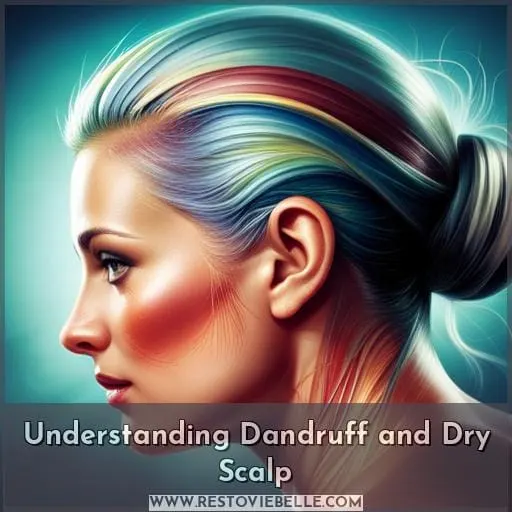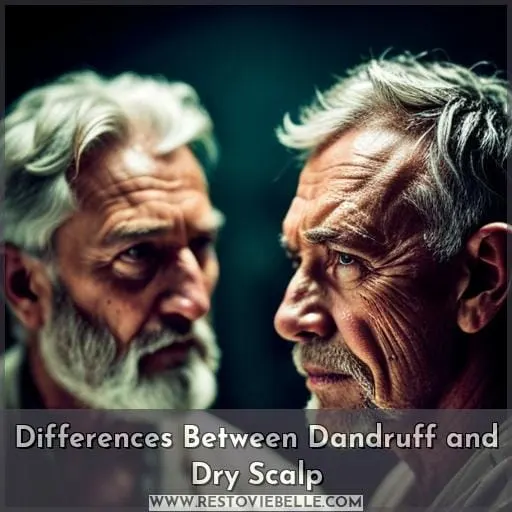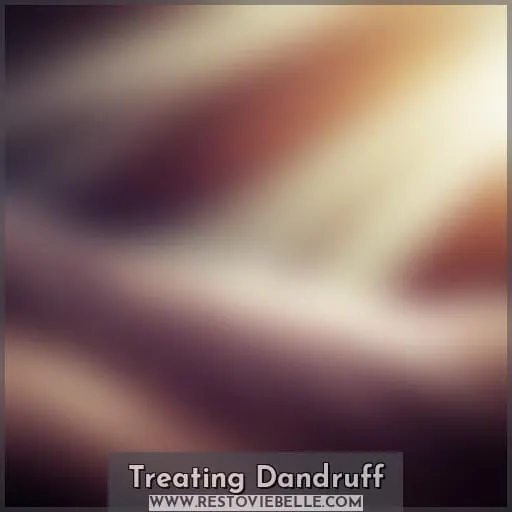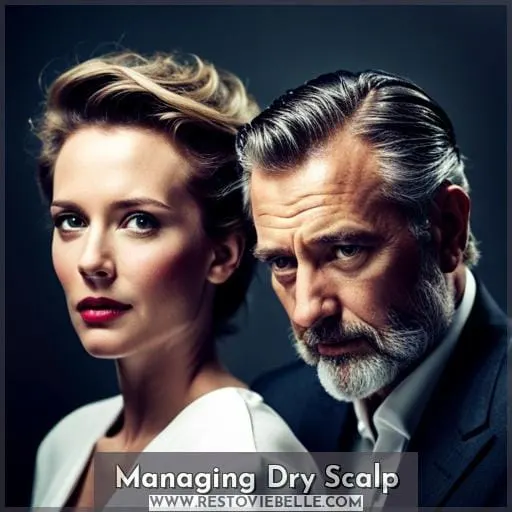This site is supported by our readers. We may earn a commission, at no cost to you, if you purchase through links.
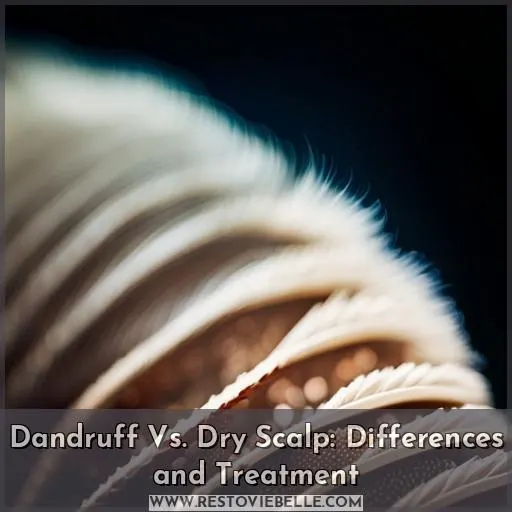 Struggling with a dry, itchy scalp? You may be wondering if you’re dealing with dandruff or just a dry scalp. While these issues can have similar symptoms, they are actually quite different and require unique treatments.
Struggling with a dry, itchy scalp? You may be wondering if you’re dealing with dandruff or just a dry scalp. While these issues can have similar symptoms, they are actually quite different and require unique treatments.
Knowing the differences between dandruff vs. dry scalp is key to getting your skin back on track and reducing any discomfort or embarrassment caused by flaky skin. In this article, we’ll explore the differences between dandruff and dry scalps as well as provide tips for managing either condition.
Table Of Contents
Key Takeaways
- Dandruff is characterized by larger, oily, yellow-tinged flakes and is caused by fungal infections, sensitivity to hair products, or the Malassezia fungus.
- Dry scalp is characterized by smaller, whiter flakes and is caused by insufficient scalp oil, often aggravated by harsh hair care products.
- Both dandruff and dry scalp can cause itching and irritation.
- Treatment options for dandruff include using anti-dandruff shampoos with ingredients like pyrithione or coal tar, while managing dry scalp involves moisturizing techniques, scalp massages, and using less irritating shampoos.
Understanding Dandruff and Dry Scalp
You may have experienced itchy, irritating flakes from your scalp and wondered if it’s dandruff or dryness that you’re dealing with. Dandruff is distinct from a dry scalp but can be caused by one. It involves visible flakes of skin due to an accelerated shedding process, which could be triggered by fungal infections, sensitivity to hair products, or the common fungus Malassezia on the scalp.
Dry scalps usually lack sufficient oil, leading to flaking and itching too. However, their smaller white flakes differ in appearance compared to the larger yellow-tinged ones seen in dandruff cases. Both conditions cause discomfort like intense itching, possibly leading someone to scratch frequently as a result.
Treating dandruff can involve anti-dandruff shampoos with pyrithione or coal tar, plus natural solutions such as tea tree oil shampoo. On the other hand, preventing dryness means using less harsh chemicals when washing hair, as well as using humidifiers for drier climates and drinking lots of water throughout the day! If home remedies don’t help, then medical attention might be required since persistent issues could signify other underlying conditions like psoriasis or seborrheic dermatitis, needing specific treatments instead.
Differences Between Dandruff and Dry Scalp
When it comes to dandruff vs dry scalp, there are key differences in flake characteristics and symptoms. Dry scalp flakes are usually smaller and whiter compared to larger, oily, or yellow-tinged dandruff flakes.
Both conditions cause itching and irritation, but oiliness and intense itching can indicate the presence of dandruff.
Flake Characteristics
Comparing the flakes from your scalp can help you distinguish between dandruff and dryness. Dandruff tends to appear as large, oily or yellow-tinged flake particles, while dry scalp will manifest in smaller, whiter flakes.
The texture of the scalps also varies. If it is flaky with an itchier feeling, then a flare-up of dandruff could be possible. On the other hand, dryness usually presents itself through tight skin without any irritation.
Flare-up triggers vary too. For example, harsh hair care products may cause both conditions but can have more dramatic effects on those prone to dandruff due to their sensitivity levels when exposed to chemical compounds found in such items.
If unsure about what condition affects you, seeking advice from a dermatologist might prove helpful before attempting home remedies that may not really address underlying causes properly!
Symptoms
Both conditions can cause itching and irritation, potentially leading to persistent scratching. Dandruff often features intense itching along with oiliness, while dry scalp causes milder discomfort. Flakes from dandruff are typically larger and may even be yellow-tinged or greasy in texture compared to the smaller flakes of a dry scalp, which tend to be lighter in color.
Scalp psoriasis and seborrheic dermatitis can also resemble dandruff but require medical attention for proper treatment approaches. Itching differences, flakes comparison, scalp irritation caused by either condition, as well as the effects of excess dryness, all need to be taken into account when selecting appropriate treatments for both dandruff and a dry scalp.
Treating Dandruff
When it comes to treating dandruff, the right shampoo or tea tree oil can make a world of difference. Anti-dandruff shampoos with pyrithione or coal tar are suitable for most cases, while natural remedies like tea tree oil shampoo provide an alternative option.
Dandruff Shampoo
Treating dandruff may involve specialized shampoo with pyrithione or coal tar to manage the accelerated shedding of dead skin cells. Scalp hydration is also key, as dry air and stress can contribute to flaky scalp conditions.
When selecting a shampoo, it’s important to consider whether you’re dealing with a fungal infection or other causes of itchiness. Tea tree oil has been known for its antifungal properties and is often used in natural remedies for dandruff relief.
Look out for medicated shampoos containing anti-fungal ingredients like ketoconazole which target malassezia yeast on the scalp; they’ll help reduce inflammation while moisturizing your locks too!
Finally, if your symptoms persist despite trying different products at home, consulting a doctor would be wise: prescription strength solutions might provide extra itch relief from stubborn cases of dandruff vs dry scalp flare ups!
Dandruff Tea Tree Oil
Using tea tree oil shampoo is an effective, natural way to manage dandruff symptoms and soothe the scalp with a gentle touch. Tea tree oil offers many benefits for scalp care, including moisturizing, balancing moisture levels, cleansing impurities, and treating irritated skin.
It’s also important to note that tea tree oil must be diluted when used on the scalp due to its potency.
To apply tea tree oil, you can add several drops of pure essential oils directly onto your hands before applying it into wet hair or mix a few drops with shampoo during washing routines. Alternatively, you can use jojoba and coconut oils as substitutes if you prefer not to use tea tree products in your routine.
When considering safety precautions for using any home treatment remedy like this one, it’s always best practice to do patch tests first. Apply some of the product behind ears or on other areas of the body 24 hours prior to use near the eyes or scalp area.
Managing Dry Scalp
Now, let’s look at how to manage dry scalp. Moisturizing techniques, such as using anti-dandruff shampoo and natural oils, can help reduce the flaking associated with a dry scalp. Scalp massages are also beneficial for stimulating circulation in the area and helping improve hydration levels.
Natural remedies like apple cider vinegar or honey can be applied directly to the scalp before rinsing out after 15 minutes. Hydration tips include drinking plenty of water throughout the day, eating hydrating foods like cucumbers or celery sticks, and avoiding excessive caffeine consumption, which may dehydrate you further.
Lifestyle adjustments, such as wearing breathable hats during hot weather days or using a humidifier while sleeping, are effective ways to combat symptoms of dry scalp over time.
Myth Busting and Additional Information
Despite common beliefs, poor hygiene is not the cause of dandruff – as they say, it’s often a case of too much of a good thing! Scalp health and hair care can be confused with one another. Fungal infections are usually responsible for persistent cases but these may also resemble seborrheic dermatitis or psoriasis.
To counter this type of dandruff, special shampoos containing pyrithione zinc or coal tar should be used. Natural remedies such as tea tree oil shampoo are worth trying if conventional treatments fail to work.
There are several ways to prevent dry scalp from occurring:
- Using less irritating shampoos
- Moisturizing your hair regularly
- Washing your hair less frequently
- Humidifying the air in winter seasons when the air tends to get drier than usual
- Drinking more water throughout the day helps keep skin hydrated – all contributing factors that could help reduce any flaking sensation on our scalps!
Lastly, avoiding excessive exposure to harsh chemicals like alcohol-based products found in some styling gels will minimize potential damage caused by long-term use.
Myth busting aside, understanding what we need specifically for maintaining healthy scalps is essential knowledge that everyone should possess – regardless if you suffer from an extreme condition such as psoriasis or just experience an occasional bout with flakes due heightened stress levels now and then – being informed will only empower us further down our journey towards better scalp health!
Conclusion
It’s easy to mistake dandruff and dry scalp, but they are different conditions with different treatments. Dandruff is characterized by larger, oily flakes, while dry scalp has smaller, whiter flakes. Dandruff is usually managed with specialized shampoos and tea tree oil, while a dry scalp may require more gentle shampoos, moisturizing shampoos, and increased hydration.
Poor hygiene does not cause dandruff, yet many myths persist. Like a jigsaw puzzle, understanding the differences between dandruff and dry scalp can help you find the pieces to put your scalp health back together.

